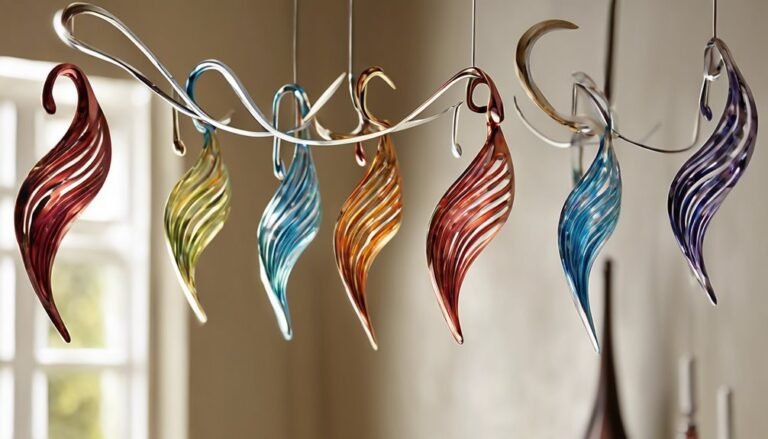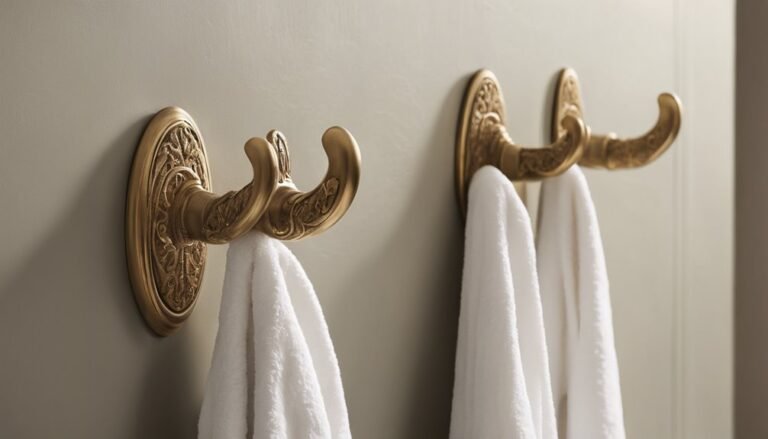How to Paint and Customize Wall Hooks
Choosing the Right Wall Hooks
When it comes to choosing the right wall hooks, the options can feel overwhelming. You'll want to evaluate both decorative styles and hook materials to find what suits your space best. Think about the overall aesthetic of your room—do you prefer modern, rustic, or vintage vibes? This will guide you in selecting hooks that complement your decor.
Next, pay attention to the materials. Metal hooks can add a sleek touch, while wooden ones offer warmth and charm. Don't forget about functionality; heavier items may require sturdier materials. By balancing style and practicality, you'll create an organized space that reflects your personality. So, take your time and choose hooks that not only serve a purpose but also elevate your home's vibe.
Gathering Your Supplies
To get started on painting your wall hooks, you'll need a few essential supplies that make the process smooth and enjoyable. Having a solid supply checklist will help you stay organized and make the most of your creative time. Here's what you should gather:
- Sandpaper or a sanding block
- Primer spray paint
- Acrylic paint in your chosen colors
- Paintbrush or sponge applicator
- Clear sealant spray
Preparing the Hooks for Painting
With your supplies gathered, the next step is preparing the hooks for painting. Start by cleaning the surface of the hooks to guarantee paint adheres properly. Use a damp cloth to wipe away dirt, dust, and grease. If your hooks have any rust, it's essential to remove it. Sandpaper or a wire brush works wonders for this task. Once clean and rust-free, you can proceed to the next phase.
Here's a quick reference table to help you:
| Task | Purpose |
|---|---|
| Cleaning surface | Guarantees good adhesion |
| Removing rust | Prevents flaking paint |
| Drying completely | Avoids moisture issues |
| Inspecting hooks | Guarantees quality finish |
| Priming (optional) | Prepares for paint |
Now you're ready for the next steps!
Selecting Your Paint and Design
Choosing the right paint and design for your wall hooks can elevate their aesthetic and functionality. To make the best choices, consider color theory and look for design inspiration that resonates with your style. Here are some tips to guide you:
- Think about your space: Match your hooks to the room's color palette.
- Choose a finish: Decide between matte, gloss, or satin for different effects.
- Explore patterns: Geometric or floral designs can add a unique touch.
- Consider functionality: Bright colors can help hooks stand out for easy access.
- Get creative: Mix and match styles for a playful vibe.
Painting Techniques for Wall Hooks
After settling on the perfect paint and design for your wall hooks, it's time to explore effective painting techniques that will help you achieve a professional finish. Experimenting with color blending techniques can create stunning effects, while varied brush stroke styles can add texture and depth. Here's a quick table to guide you:
| Technique | Description |
|---|---|
| Color Blending | Mix two colors for a gradient effect. |
| Dry Brushing | Use a dry brush for a textured look. |
| Stippling | Apply paint with a stippling motion for added dimension. |
These techniques not only enhance aesthetics but also allow for your unique flair. Don't hesitate to try different approaches until you find the perfect match for your hooks!
Sealing and Finishing Touches
Now that you've painted your wall hooks, it's time to focus on sealing and finishing touches to protect your hard work. Choosing the right sealant and applying finishing coats will guarantee your hooks remain durable and look great for years to come. Let's explore how to achieve that perfect protective finish!
Choosing the Right Sealant
When it comes to finishing your painted wall hooks, selecting the right sealant can make all the difference in durability and appearance. You've got several sealant types to choose from, each with unique benefits. Consider these options:
- Polycrylic: Great for water-based paints, it's easy to apply.
- Polyurethane: Offers powerful protection, perfect for high-traffic areas.
- Acrylic Sealant: Flexible and ideal for indoor use.
- Epoxy: Provides a hard finish, excellent for heavy-duty hooks.
- Spray Sealants: Quick application method, delivering even coverage.
Choosing the right sealant guarantees your hooks not only look fantastic but also withstand the test of time. So, evaluate your needs and enjoy the freedom of customizing your space!
Applying Finishing Coats
Seal your hard work with the perfect finishing coats to elevate your painted wall hooks. Applying finishing techniques, like spray sealants or brush-on finishes, guarantees your hooks not only pop but also stand the test of time. Start by selecting a protective coating that suits your hook's material—polyurethane for wood or acrylic for metal. Make certain to apply thin, even layers, allowing each coat to dry before adding the next. This not only enhances the color but also provides a barrier against wear and tear. Don't forget to follow the manufacturer's instructions for the best results. With these finishing touches, your customized wall hooks will shine and serve you well, adding a touch of your unique style to your space.
Ensuring Durability and Protection
After applying those finishing coats, it's important to think about how to secure your wall hooks withstand everyday use. You want to ascertain durability factors and protection methods are in place for lasting appeal. Here are some practical tips:
- Use a clear sealant for extra protection.
- Choose high-quality paint designed for durability.
- Avoid exposing hooks to excessive moisture.
- Regularly check for wear and touch-up as needed.
- Hang only items that won't exceed the hooks' weight limit.
Installing Your Customized Wall Hooks
Installing your customized wall hooks can transform both functionality and aesthetics in your space. Start by deciding on the hook placement—think about where you need extra storage or a pop of color. For best results, measure and mark the spots on your wall before drilling. Use a level to guarantee your hooks are straight, as uneven placement can detract from their visual appeal. For installation tips, choose the right anchors based on your wall type; drywall requires different hardware than masonry. Once secured, hang your items and enjoy your personalized space! Don't forget to step back and admire your handiwork—you've just added a unique touch that reflects your style and enhances your home's atmosphere.
Frequently Asked Questions
Can I Use Spray Paint on Metal Wall Hooks?
Yes, you can use spray paint on metal wall hooks! Just make certain to properly prep the metal surface first. Using correct spray paint techniques will guarantee a smooth, lasting finish that enhances your decor.
How Do I Remove Old Paint From Wall Hooks?
To remove old paint from wall hooks, try sanding techniques for a straightforward approach. If that doesn't work, consider using chemical removers for tougher layers. Always guarantee you're in a well-ventilated area for safety!
What Type of Primer Is Best for Wall Hooks?
When choosing primer types for wall hooks, consider an oil-based or bonding primer for metal surfaces. Proper surface preparation guarantees better adhesion, so clean and sand the hooks before applying the primer for lasting results.
Are There Specific Paints for Outdoor Wall Hooks?
Choosing paints for outdoor wall hooks is like selecting armor for a knight. Look for weather-resistant options that offer durability factors against the elements, ensuring your hooks stay vibrant and functional through rain or shine.
How Long Should I Wait Before Using Painted Hooks?
You should wait at least 24 hours after painting before using your hooks. This allows for proper drying time, but remember, full paint curing might take up to a week, so give it some extra patience!







